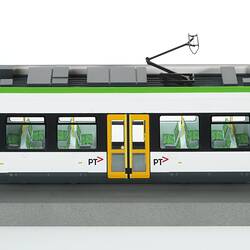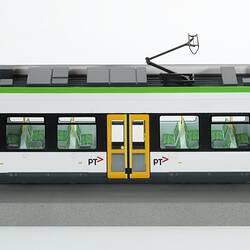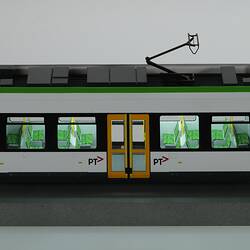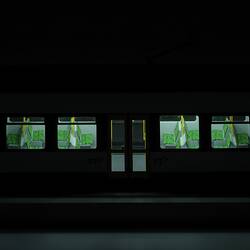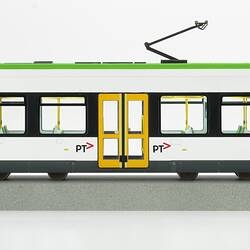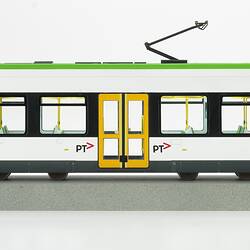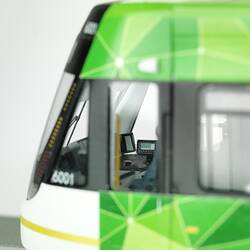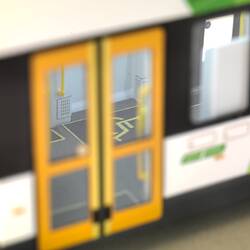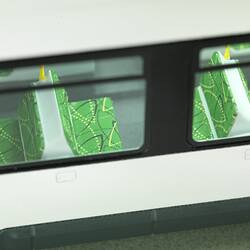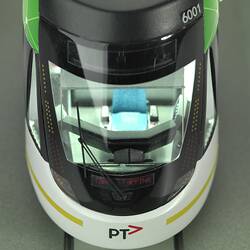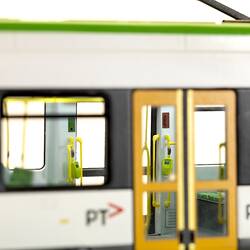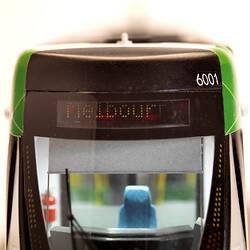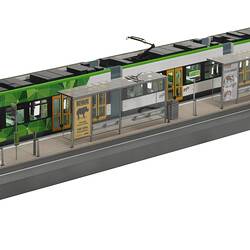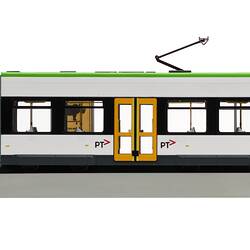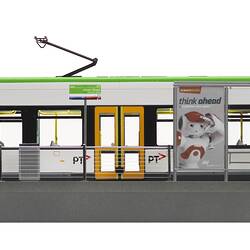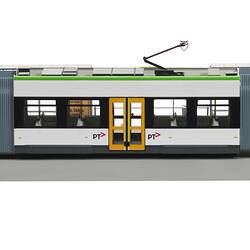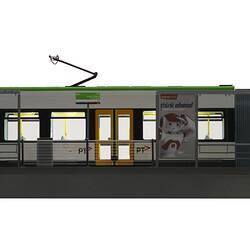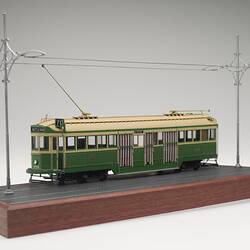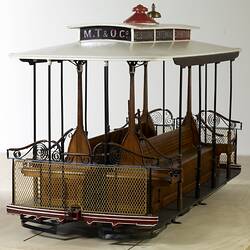Summary
Model of the latest articulated, low-floor tram design to be added to Melbourne's tram fleet, known as the 'Flexity' or E-class tram, assembled by Bombardier Transportation, at Dandenong, Victoria, from imported and local components. The model includes a representation of a Melbourne tram 'Superstop' (now officially known as 'Accessible tram stops'), based on a actual tram stop in Nicholson Street, outside the Parliament underground train station. The stop includes a section of roadway with a single tram track, a raised platform with ramps at either end, safety railings, two glazed passenger shelters (with advertising panels), pedistrian crossing and a traffic light. Model scale: 1:48 (1/4-inch to the foot).
The model was commissioned by Museum Victoria in 2013 for the Transport Collection and is featured in the Transport Showcase of the Scienceworks 'Think Ahead' Exhibition. It was constructed by model maker, Mark O'Brien. The model was fabricated by first drawing a digital 3D CAD model of a full-size tram based on digital drawings and documents provided by the manufacturer and on photographs, inspections and measurements taken from an actual tram. While the majority of the components were made using traditional modelmaking materials, some components were 3D printed in plastic. Each component was hand-painted and assembled using adhesive. The exterior colour scheme was applied as colour printed adhesive labels based on digital copies of the actual artwork supplied by the manufacturer. The model incorporates activatible LED headlights and interior cabin lighting.
Prior to 2013, the tram fleet operating in Melbourne was comprised of eight different classes of vehicles: W (1950s), Z (1975), A (1983), B (1984), C1 (2001), D1 (2002), D2 (2004) and C2 (2008). Melbourne's early electric trams up to the last W-class trams, the W7 series introduced in 1956, used direct-current traction motors with rheostat type speed controls that varied voltage to the motors. All of the modern generations of trams from the Z-class onwards have employed solid-state thyristor power control systems that convert the 600-volt direct-current power from the overhead electric tram wires into alternating-current, which is then modulated by 'clipping' the sinewave form voltage to control the speed and power output of the tram motors. This modern technology has the advantage of being far more efficient than the older style trams. It removed the resistance banks in the rheostats that generated wasted heat, and, by allowing the traction motors to turn into generators when a tram is decelerating or braking, converts the kinetic energy of the vehicle into electric current that can be fed back into the overhead wires to power other trams or reduce overall power consumption across the network.
The first articulated tram vehicles introduced in Melbourne (also known as 'light rail') were the B-class of 1984. These were followed by the innovation of the first low-floor, articulated trams introduced with the C1-class in 2001 (and three subsequent classes). All of the current low-floor articulated trams currently in use in Melbourne have been built by either Alstom (France) or Siemens (Germany) and are based on technology previously introduced in many overseas cities. The Department of Transport, Victoria (now Public Transport Victoria) has been progressively upgrading Melbourne's tram infrastructure, building "super stops" with slightly elevated platforms and introducing more low floor vehicles to meet increased capacity and accessibility requirements.
In 2010, the State Government authority Public Transport Victoria (PTV) awarded a contract for 50 new articulated, low-floor trams to Bombardier Transportation. Each tram is rated to carry up to 64 seated and 150 standing passengers. The firm's Dandenong-based works will manufacture the tram bodies and assemble the trams with imported bogies from France, with the first new trams due to enter service on the network in July 2013.
Physical Description
Scale model of an articulated tram (three carriages) mounted in a tram stop streetscape. The tram stop includes poster signage relating to a tram safety campaign and advertising for the Think Ahead exhibition at Scienceworks.
Significance
Scale models have long formed a key interpretative approach in depicting the story of technological development in areas such as transport, engineering and mining where the acquisition of full-size artefacts is often impractical, particularly when considered for display within a traditional museum setting. Museum Victoria has a large and historically significant collection of scale models dating back to the museum's earliest years in the 1850s, depicting shipping, railways, mining, agricultural machinery, steam engines and other aspects of engineering.
More Information
-
Collecting Areas
-
Acquisition Information
Commission from Mark O'Brien - Benchmark Modelmaking, 25 Oct 2013
-
Modelmaker
Mark O'Brien - Benchmark Modelmaking, Victoria, Australia, 2013
-
Organisation Named
Public Transport Victoria, Melbourne, Victoria, Australia, 2013
-
Organisation Named
-
Inscriptions
Driver cabin: ' PTV ', ' 6001 ' Streetscape signage: ' BEWARE / [image of rhino] / A tram weighs / as much as 30 rhinos / LOOK. LISTEN / Be alert around trams ', ' SCIENCEWORKS / think ahead / Exhibition now open '
-
Classification
-
Category
-
Discipline
-
Type of item
-
Overall Dimensions
690 mm (Length), 52 mm (Width), 98 mm (Height)
Dimensions of model only. Dimensions of model on base: Length: 1075mm; Depth: 149mm; Height: 117mm (Height of base only: 19mm)
-
Model Scale
1:48
-
References
Media Release, Bombardier Wins Contract for 50 Trams for One of the World's Largest Tram Operations in Melbourne, Australia, 29 Sep 2010. Retrieved 4 Mar 2013 from [Link 1] Media Release, 50 New Trams, Public Transport Victoria. Retrieved 4 Mar 2013 from [Link 2] Media Release, Tram route 96 to be upgraded ahead of new trams, Minister for Transport, 17 Apr 2012. Retrieved 4 Mar 2013 from [Link 3]
-
Keywords
Trams, Modelmaking, Models & Modelmaking, Public Transport, Road Safety, Road Safety Barriers

